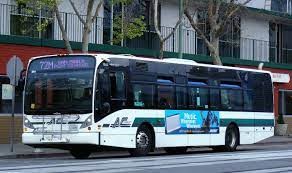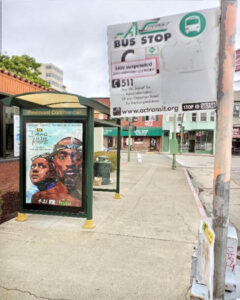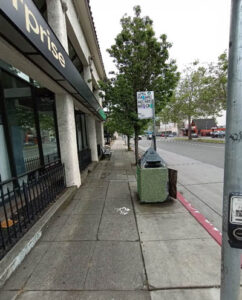Last Time You Rode a Bus
 When was the last time I rode a bus? I had to think about this as I filled out the AC Transit survey. I had to admit it’s probably been months. Why is that? Is it just because I’m a car-owning, bike-riding retiree? It made me wonder how many others in our neighborhood shared my avoidance for this key public service.
When was the last time I rode a bus? I had to think about this as I filled out the AC Transit survey. I had to admit it’s probably been months. Why is that? Is it just because I’m a car-owning, bike-riding retiree? It made me wonder how many others in our neighborhood shared my avoidance for this key public service.
The Agency has been in operation since 1960 and is the third largest bus-only transit agency in the U.S. (Why is it “bus-only”? That is a good question.) It serves 1.5 million residents over a 364-square-mile service area. It operates 633 busses over 128 lines. One can travel from Pinole to San Francisco, Fremont and even Stanford on AC Transit busses. (Sorry, no Marin service.)
The Piedmont Avenue neighborhood is served most directly by the 12 line which runs from Gilman in Berkeley, along MLK to 51st, from there to Piedmont, to Linda, and down Grand to the lake, terminating at the Oakland Amtrak.
Intervals are 20 minutes with the first bus at Piedmont and Linda at 6:17 am, and the last one at 12:40 am. Other buses run on the edges, like the 51 along Broadway and the transbay bus O that runs on Oakland Avenue up into Piedmont.
Breakfast Briefings
 Since the pandemic, AC Transit began a series of Breakfast Briefings in each of the five wards that comprise the District. Piedmont Avenue and North Oakland and Berkeley are in Ward 2, which is served by Director Jean Walsh. We are also fortunate to have Chris Peeples, long time PANIL Steering Committee member, serving as an AC Transit Director at Large.
Since the pandemic, AC Transit began a series of Breakfast Briefings in each of the five wards that comprise the District. Piedmont Avenue and North Oakland and Berkeley are in Ward 2, which is served by Director Jean Walsh. We are also fortunate to have Chris Peeples, long time PANIL Steering Committee member, serving as an AC Transit Director at Large.
At the May 3 presentation, Directors Syad (Alameda) and Peeples (at-large) introduced General Manager Michael Hursh to the audience of about 30 community representatives. Mr. Hursh touted the great strengths of the system. AC Transit prides itself on providing transportation to those who have no other options; 65% of its passengers are low income and 43% have no access to cars.
The General Manager frequently mentioned how green AC Transit is in its wide deployment of zero-emissions hydrogen-powered busses. He noted that, unfortunately, this adds to the costs per mile as 95% of hydrogen produced requires fossil fuels, only pushing greenhouse gas production upstream. He noted that green hydrogen (produced from clean energy) is in its infancy, and he said the District will look to that resource when it becomes available.
Hursh described as another exciting development the implementation of a Bus Rapid Transit (BRT) system, dubbed Tempo, along International Boulevard. BRT systems have dedicated lanes and traffic controls that allow the busses to move unimpeded by other vehicles. This allows the line to maintain highly reliable schedules which has resulted in growing use of this line. Mr. Hursh urged attendees to give the line a try.
He also sounded alarms for the District. It’s no secret that transit agencies across the state country are feeling the pinch of the pandemic in reduced ridership and fare recovery. Ultimately the viability of these systems as we know them will be more and more threatened. Weekday ridership on the bus system averages about 120,000, down about 35% from pre-pandemic levels. Other agencies have suffered more — BART is down about 70% from high pre-pandemic level. BART daily ridership is about 140,000 and covers five counties, and has double the operating budget of AC Transit, which is a hefty $500 million.
On the income side, the District has a variety of sources. A small portion comes from the farebox, about $50 million from the federal government, some from sales tax, and the most from property taxes. Federal funding will soon come to an end. All agency speakers urged attendees ask their legislators at State and Federal levels for more funding.
There is also a dire need for bus drivers. The District is offering a hiring bonus and a great benefits package. In the face of driver shortage, and because wages and benefits are by far the greatest expenses, I asked if AC Transit is looking at autonomous vehicles. Mr. Hursh said only that their bus suppliers don’t offer those, and AC Transit is not looking elsewhere.
One solution to shortage might require length the 20-minute intervals between busses to 22 minutes, he stated.
The AC Transit Realign Survey
 One of the most important initiatives underway is the “Realignment,” a comprehensive review of all the routes and frequencies in the system. The “new normal” of telecommuting brought about by the pandemic has decimated downtown SF offices. New transportation options compete with private autos as well as busses. Changes in demographics are also occurring as cities, particularly in Oakland and Berkeley, where we are seeing a boom in dense housing on urban corridors. To grow and maintain usefulness, the agency has to adapt. The AC Transit Realign Survey is being circulated to get input from residents. This information will be critical to planning. Please take the survey at this link, actransit.org/realign, and urge your friends to do so as well so that, maybe, with the changes now in the planning stages, it won’t be so hard to remember the last time you took a bus.
One of the most important initiatives underway is the “Realignment,” a comprehensive review of all the routes and frequencies in the system. The “new normal” of telecommuting brought about by the pandemic has decimated downtown SF offices. New transportation options compete with private autos as well as busses. Changes in demographics are also occurring as cities, particularly in Oakland and Berkeley, where we are seeing a boom in dense housing on urban corridors. To grow and maintain usefulness, the agency has to adapt. The AC Transit Realign Survey is being circulated to get input from residents. This information will be critical to planning. Please take the survey at this link, actransit.org/realign, and urge your friends to do so as well so that, maybe, with the changes now in the planning stages, it won’t be so hard to remember the last time you took a bus.
— Bill Manley, Member of the PANIL Steering Committee
